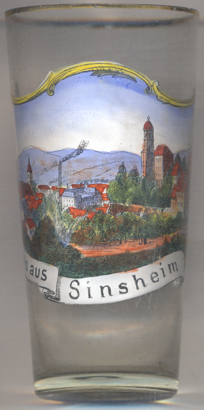

|
| DEUTSCHLAND | GERMANY |
| Bundesland: Baden-Württemberg | |
| Regierungsbezirk: Karlsruhe | |
| Landkreis: Rhein-Neckar-Kreis |
Sinsheim is situated at an elevation of 154 m on the river Elsenz, about 22 km southeast of Heidelberg and 28 km northwest of Heilbronn in the Rhein-Nackar district of northwestern Baden-Württemberg. The municipality has a population of about 35,400 (2017).
 The region around Sinsheim has been settled since 700,000 BC, as shown by the finding of the fossil Homo heidelbergensis
in the village of Mauer, about 12 km north of Sinsheim. The Romans ruled the area from 90 AD to 260 AD.
Sinsheim was first mentioned in 770 AD in the Codex of the cloister Lorsch. Sinsheim monastery was founded around
1000 AD. Sinsheim obtained the privilages of a market town in 1064, the right to mint coins in 1067, and the
privileges of a city in 1192. Since 1329 it belonged to the Electoral Palatinate. In 1803, the Palatinate territories
east of the Rhine were allocated to the former margraviate, now Electorate (in 1806 Grand Duchy) Baden.
Sinsheim, however, at first was given to the newly established Principality of Leiningen, before also passing to Baden in
1806 and becoming a district town. The district was enlarged by merging it with the former district of Neckarbishofsheim.
The new railroad from Meckesheim to Jagstfeld was built in 1868/69, which brought an important economic upswing. The railroad
connection to Eppingen followed in 1900. In 1924, The former district Eppingen was added to the district Sinsheim in 1924.
The district was dissolved in 1973 and was divided between the district Rhein-Neckar and Heilbronn.
In 1071–1973 the neighbbouring communities of Dühren, Hilsbach, Weiler, Adersbach, Ehrstädt, Hasselbach,
Rohrbach, Eschelbach, Hoffenheim, Reihen, Waldangeloch and Steinsfurt were incorporated into the municipality of Sinsheim.
The region around Sinsheim has been settled since 700,000 BC, as shown by the finding of the fossil Homo heidelbergensis
in the village of Mauer, about 12 km north of Sinsheim. The Romans ruled the area from 90 AD to 260 AD.
Sinsheim was first mentioned in 770 AD in the Codex of the cloister Lorsch. Sinsheim monastery was founded around
1000 AD. Sinsheim obtained the privilages of a market town in 1064, the right to mint coins in 1067, and the
privileges of a city in 1192. Since 1329 it belonged to the Electoral Palatinate. In 1803, the Palatinate territories
east of the Rhine were allocated to the former margraviate, now Electorate (in 1806 Grand Duchy) Baden.
Sinsheim, however, at first was given to the newly established Principality of Leiningen, before also passing to Baden in
1806 and becoming a district town. The district was enlarged by merging it with the former district of Neckarbishofsheim.
The new railroad from Meckesheim to Jagstfeld was built in 1868/69, which brought an important economic upswing. The railroad
connection to Eppingen followed in 1900. In 1924, The former district Eppingen was added to the district Sinsheim in 1924.
The district was dissolved in 1973 and was divided between the district Rhein-Neckar and Heilbronn.
In 1071–1973 the neighbbouring communities of Dühren, Hilsbach, Weiler, Adersbach, Ehrstädt, Hasselbach,
Rohrbach, Eschelbach, Hoffenheim, Reihen, Waldangeloch and Steinsfurt were incorporated into the municipality of Sinsheim.
 Sinsheim monastery [left, no. 3551: right] was founded around
1000 AD. Around 1092/1100 it became a Benedictine monastery. In 1496 it became a collegiate church, which,
however, was dissolved in 1565. During the following centuries the buildings began to decay until in 1887 they became home
to a children reformatory that today operates as a state-owned non-profit limited-liability company under the name
'Stift Sunnisheim'. The former monastery church, in its core dating from the 10th century, was converted to a
cultural centre.
Sinsheim monastery [left, no. 3551: right] was founded around
1000 AD. Around 1092/1100 it became a Benedictine monastery. In 1496 it became a collegiate church, which,
however, was dissolved in 1565. During the following centuries the buildings began to decay until in 1887 they became home
to a children reformatory that today operates as a state-owned non-profit limited-liability company under the name
'Stift Sunnisheim'. The former monastery church, in its core dating from the 10th century, was converted to a
cultural centre.
The Protestant  town church [background left] goes back to a church dedicated
to St. Jacob from the 12th century. It became Protestant when the Reformed faith was introduced in Sinsheim
in 1553. From 1697 the church was used as a simultaneum by both the Protestant and the Catholic community. In 1707, the
choir was given to the Catholics while the nave was to be used by the Protestants; a wall between the two parts was
built in 1712. The nave was rebuilt in 1717 and again in 1766–1782. The choir was renewed in 1788, the tower followed
until 1806. The church remained in use by both confessions until the completion in 1967 of the new Catholic church of
St. Jacob the Elder.
town church [background left] goes back to a church dedicated
to St. Jacob from the 12th century. It became Protestant when the Reformed faith was introduced in Sinsheim
in 1553. From 1697 the church was used as a simultaneum by both the Protestant and the Catholic community. In 1707, the
choir was given to the Catholics while the nave was to be used by the Protestants; a wall between the two parts was
built in 1712. The nave was rebuilt in 1717 and again in 1766–1782. The choir was renewed in 1788, the tower followed
until 1806. The church remained in use by both confessions until the completion in 1967 of the new Catholic church of
St. Jacob the Elder.
[https://de.wikipedia.org/wiki/Sinsheim, https://en.wikipedia.org/wiki/Sinsheim;
https://de.wikipedia.org/wiki/Stift_Sinsheim;
https://de.wikipedia.org/wiki/Evangelische_Stadtkirche_Sinsheim]
![[scale]](lineal.jpg)